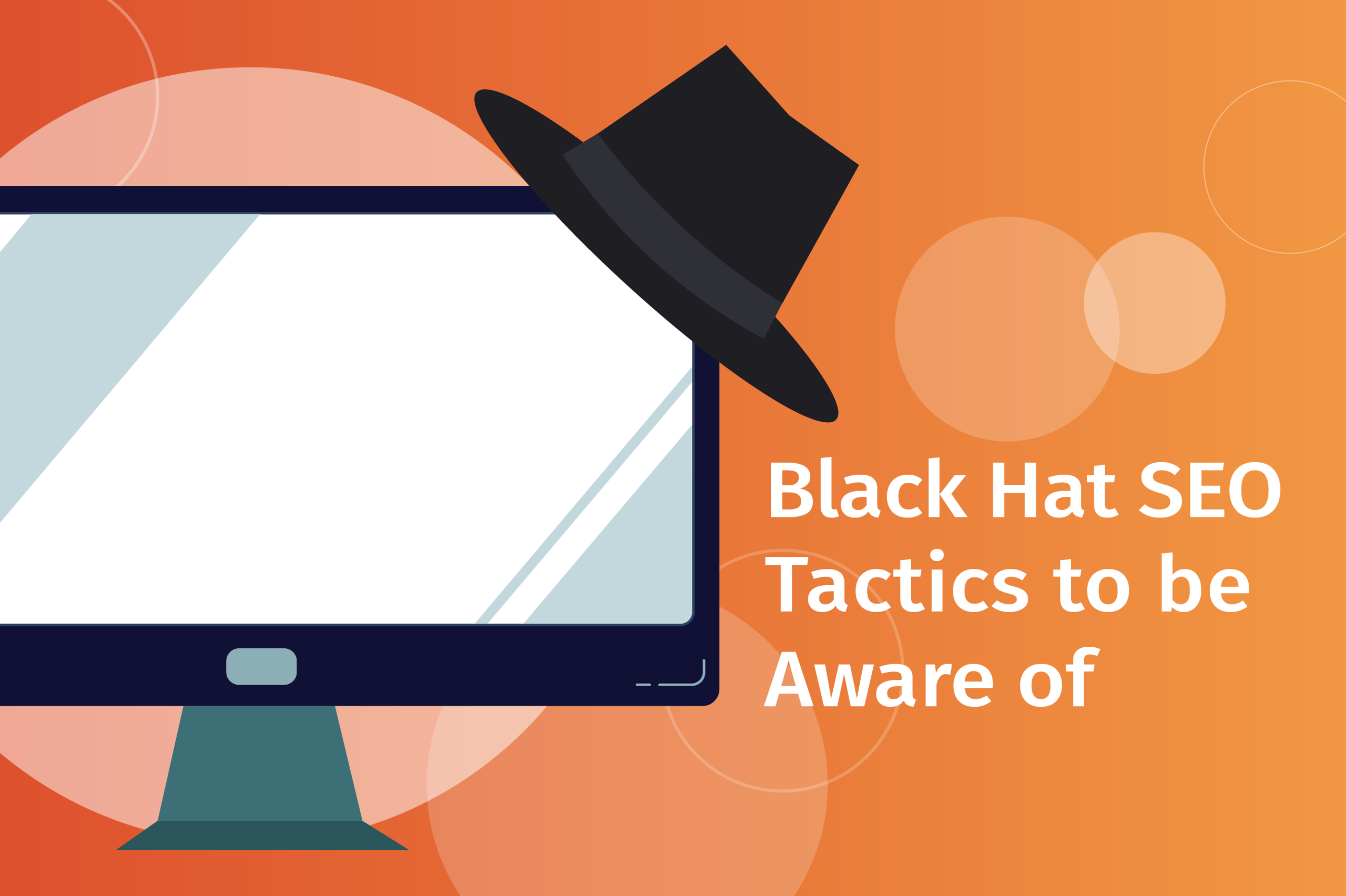
Search engine optimization (SEO) is no easy feat. It can take months if not years to crawl your way up to the coveted first page of a search engine results page (SERP).
Unfortunately, this isn’t a reality some people working on SEO can swallow. Instead of putting in good, honest work to win over the Almighty Algorithm, some individuals will engage in less-than-savory behaviors to cheat their way to the top. This practice is called black hat SEO.
What is Black Hat SEO?
Black hat SEO is the act of manipulating search engines in order to rank higher faster.
Wait… isn’t that just regular old SEO? No.
SEO is the practice of adhering to search engine rules, working within parameters to increase website health, creating unique strategies, and focusing on users.
Black hat SEO is literally only thinking about one thing: ranking.
While it’s not illegal, this practice goes against guidelines set out by the different search engines (i.e. Google’s Webmaster Guideline or Bing’s Webmaster Guidelines). At the dawn of the internet, it was a lot easier to get away from this type of nefarious behavior. In fact, this was mostly what SEOs would do.
Algorithms simply weren’t as sophisticated as they are today so many of the tactics people would use to cheat their way to the top slipped through the cracks.
It’s virtually impossible to get away with black hat SEO in our day and age in legitimate industries. The algorithms are a lot better at spotting shady practices now. Sure, you might find short-term success with black hat SEO tricks. But sooner or later the search engines will catch on and slap you with a penalty. That can result in either a significant drop in your ranking or a complete removal from the SERP altogether.
Yes, even old domains that you can purchase today may have a history of using black hat SEO tactics, making them a poor purchase. You’d have to reinstate trust with Google. How do you know if you’re purchasing a negative domain? Work with a true SEO!
Black Hat SEO Tactics
Ethical SEO practitioners should avoid black hat SEO tactics at all costs. As a business owner, you’re likely to need to hire someone who fits your budget. This can be tricky seeing as though everyone who claims to be an SEO and will “get you to page 1! Guaranteed!” is a black hat tactic SEO.
SEO isn’t cheap, because it takes time and experience to properly get you to a good-enough ranking for a strong keyword.
If you’re just starting out with an understanding of SEO, it’s important to read up on these tactics so you don’t accidentally slip into dicey territory. We’ve experienced many business owners coming to us asking, “can you take a look at my website? I don’t understand why it’s not ranking. I pay a guy $100 a month and he says that he can get me to the top of page 1 on Google.”
Honestly, this is a tragic moment for us, especially our SEO team. We’ve heard this exact story so many times, and it’s exactly why trust is hard to come by with an SEO agency.
In the end, after pulling our audit of his website, we always come to the same conclusion: the person you’re paying does black hat SEO.
Afterward, the business owner fires the scammer and works with an SEO agency that can truly fill the needs of the business online. Whether that SEO agency is ours or another’s.
While some of these tactics we’ll go over are blatantly immoral, some might not seem so bad on the surface to the untrained eye. Take a look at these 9 black hat SEO tactics so you can know what to avoid or how to spot a scammer:
Low-Quality Content
A lot of SEO work hinges on content creation. It’s a great way to signal what you want to rank for to search engines. Websites will create quality content for their visitors to learn more about their business and related topics. Low-quality content is a black hat technique used to cheat your way to a higher rank.
Low-quality content is created by copying existing content or using other prohibited practices to trick the algorithm into thinking you have something of value to add to a user’s online search. Or it’s about having practically no content/grammatically inaccurate content.
Some people will scrape content from other websites manually or using a bot. Others might use “invisible keywords”. This tactic involves hiding words on a page by making the text and background color the same. Some might engage in “bait and switch” behavior which is the process of creating content related to a topic you want to rank for and switching the content out once it ranks. This content can sometimes not relate to your business either! It’s just there to “increase your website’s strength”.
All of these practices are black hat SEO tactics you should avoid. Search engines are better at identifying low-quality content. Google even launched an update in 2011 called Google Panda aimed at weeding out poor-quality content.
Content is still king in 2021.
Keyword Stuffing
As we already mentioned, keywords are an important tool used to communicate with search engine algorithms to convey what you want to rank for. When used correctly, you’ll eventually reach your target audience once you gain authority in your industry. But there is a time and place for keywords.
Editor’s Note: Don’t let anyone tell you that keywords aren’t a ranking factor anymore. This is a myth that can easily be debunked. Keywords are still very, very important.
Keyword stuffing is the practice of fitting as many keywords in a piece of content as possible – even if it sounds unnatural. This tactic doesn’t benefit the user at all. In fact, it makes it more difficult for them to gain any information from your content. Usually, keyword stuffing involves placing irrelevant keywords within a blog or page to rank even if it has nothing to do with the subject matter, really.
Here’s an example:
“We have the best snow cones in town. Our snow cones are perfect for a hot summer day. Snow cones come in many different flavors. Try our snow cone flavors piña colada, strawberry, and mango. Our superstar snow cone makers are ready to help you chill this summer so don’t hesitate to stop by. (SNOW CONES! 😎 )”
Do you see how annoying it can be to make it through copy like this? Yeah, okay. Maybe they might have the best snow cones in town but keyword stuffing can be off-putting and might actually dash your chances of drawing in potential customers. Try focusing on topics over keywords and take it easy on stuffing them in at any chance you get.
Mainly, the reason this is a black hat SEO tactic is that it doesn’t offer a good user experience. Wouldn’t you hate it if you were walking down a street, saw a sign that said “the best coffee for the best price in town”, walked in, and found out it was made from a cheap packet of coffee that’s been sitting on the counter for a year?
Yeah, that does sound disgusting, especially at $5 a cup.
Sneaky Redirects
Redirects are a handy tool you can use to send a user to a different URL than what they initially clicked on. You can use this tactic to get customers to a new website domain/page or to consolidate two pieces of content. Many times, redirects are used when a page is deleted and a 404 error code appears.
Some people abuse the power of redirects to trick search engines.
A sneaky redirect does not serve to solve for a user. Instead, it’s meant to trick the algorithm into thinking content is more relevant than it actually is. One way black hat SEOers use redirects is to send crawlers to a separate, more authoritative landing page than the one visitors actually clicked on. Some other methods are to redirect an authoritative page to an irrelevant page or to use a 301 redirect to transfer authority from one page to another.
Cloaking
Cloaking is similar to a sneaky redirect. Instead of sending search engine crawlers to a separate page, they alter the page so crawlers and visitors see different content on the same URL. This is also known as a URL frame. This black hat SEO tactic is used to rank for multiple irrelevant keywords. Cloaking is often used by spam sites to dodge the watchful eyes of search engines.
Think of it as variants A and B.
There are situations where you can use URL frames appropriately. Many sites use it to create a mobile version of their site or change the language depending on the region of the visitors. These uses are all a-okay as long as you’re not trying to trick the algorithm.
Comment Spamming
You may notice that some of your blog posts get a lot of dodgy comments that don’t really seem relevant to your post. They might directly promote themselves including a link to a landing page they want to rank. These are called spam comments. Some websites will use this tactic in a fruitless attempt to boost their own ranking. They can do this manually or with tools or services. They will typically find your best-performing piece of content to comment spam. The thought is that these comments will score them an easy backlink.
Most comment sections don’t actually transfer any SEO juice to the links left behind. They are automatically set to “nofollow” which signals to a crawler not to explore the link. Nevertheless, it’s still a popular black hat tactic because business owners aren’t very aware that you can stop a search engine from crawling a link. You get handed over a deliverable of “50 new links”, look at them, and see that they’re on well-known websites. You then think that you’ll have tons of SEO juice pouring into your website.
Here’s an example of a “nofollow” HTML block:

First off, even if the comment section didn’t include the nofollow tag, it still doesn’t have a strong ranking signal for search engines. So, it’s essentially useless unless other commenters want to use it as a resource and travel to your website. Otherwise, it’s pointless aside from making your website look spammy to search engines.
If you notice these comments, delete them. They can diminish a user’s experience and make you look bad. It’s a good practice to only allow comments to post after you approve them first.
Paid Links
Link building is an important branch of SEO work. Backlinks display authority and credibility to search engines. There are plenty of methods to do this in an ethical way. But, you guessed it, there are shady ways to do it too (just like the spam comments we just talked about). It’s prohibited by Google and other search engines to buy or sell links. But this is a method many black hat SEOers use to trick the algorithm into thinking they gained a legitimate backlink.
Never compensate a site to post your link – this includes free products and services. Both you and the seller could get hit with penalties once Google detects suspicious activity. If you did happen to buy a link without knowing it’s not allowed, ask the site to take it down. If they don’t get back to you, you could remove it using Google Search Console.
Link Farms
Another fraudulent way to gain backlinks is to solicit a link farm. Link farms are websites that exist for the sole purpose of creating backlinks for different websites. They will create low-quality content and link out to the site or sites that hope to rank higher on the SERPs. These links will typically contain the desired keyword in the anchor text.
Here’s an example of what anchor text looks like in an HTML block:

Google has no problem weeding out these sites over time. The low-quality content and irrelevant links are typically a dead giveaway. The site and any sites with the links featured on it will face serious penalties.
Private Blog Networks
The cousin to the link farm is the private blog network (PBN). Instead of enlisting the help of one site to host links, a PBN uses the collective power of multiple sites to create backlinks. This type of black hat SEO scheme seeks to exaggerate the number of backlinks a site has in an effort to rank higher, and faster.
Someone looking to create a PBN will normally buy up expiring domains with established authority. Once they secure their network, they will create content that corresponds to what these sites already have hosted. They will work in links to their main website throughout this content. Even after all this effort, a PBN is unlikely to survive for long. Google is getting really good at tracking down these networks and shutting them out.
Structured Data
Web developers use structured data to change the way content is displayed on a search engine. You might also hear this referred to as “rich snippets” or “schema”. It can be a handy way to show a searcher some interesting additional information about your page on the SERP. While using rich snippets won’t give you a ranking boost on its own it can increase click-through rates which, in turn, will improve your ranking.
Rich snippets can include information on:
- Ratings
- Recipe
- Music
- An Organization
- Product Markup
The black hat version of structured data will take advantage of this feature to mislead users into clicking on their links. They might create a fake review or use some other piece of schema to draw a user’s eye. If you notice this type of behavior, report it to Google or Bing right away. But, remember, falsely accusing a competitor can get you into hot water.
What is Grey Hat SEO?
SEO is constantly changing as search engines roll out updates to their algorithms. The definition of what is a blatant black hat SEO tactic can shift alongside these updates as Google and other search engines pick up on new ways people are attempting to game the system. This is where grey hat SEO might make an appearance.
Grey hat SEO isn’t necessarily against guidelines but it also isn’t totally ethical. These practices might not be prohibited now but that doesn’t mean they won’t cause you issues further down the line. Some of the tactics we listed above were once considered gray-hat until search engines cracked down on them. Be wary when you tread into gray-hat territory.
Some grey hat practices include:
- Linking your site to a web 2.0 site
- Abusing social bookmarking sites
- Irrelevant or excessive link exchange between sites
Choose White Hat SEO
The best way to build a reputable site is to use white-hat SEO tactics. These are the classic, ethical practices used to gain authority and rank. Roll up your sleeves and earn your way to the top! Keep the user at the center of everything you do to optimize your rank on the SERP. At the end of the day, search engines want users to have a good experience, not feed them irrelevant, hollow information. You can get in the good graces of the algorithm by creating quality content and a better overall experience for visitors to your site.
If you need help with SEO or any other facet of your online presence, Beyond Blue Media is at your disposal! We work with businesses to create a stellar marketing plan tailored to your unique business needs. Get in touch with us for more information!


